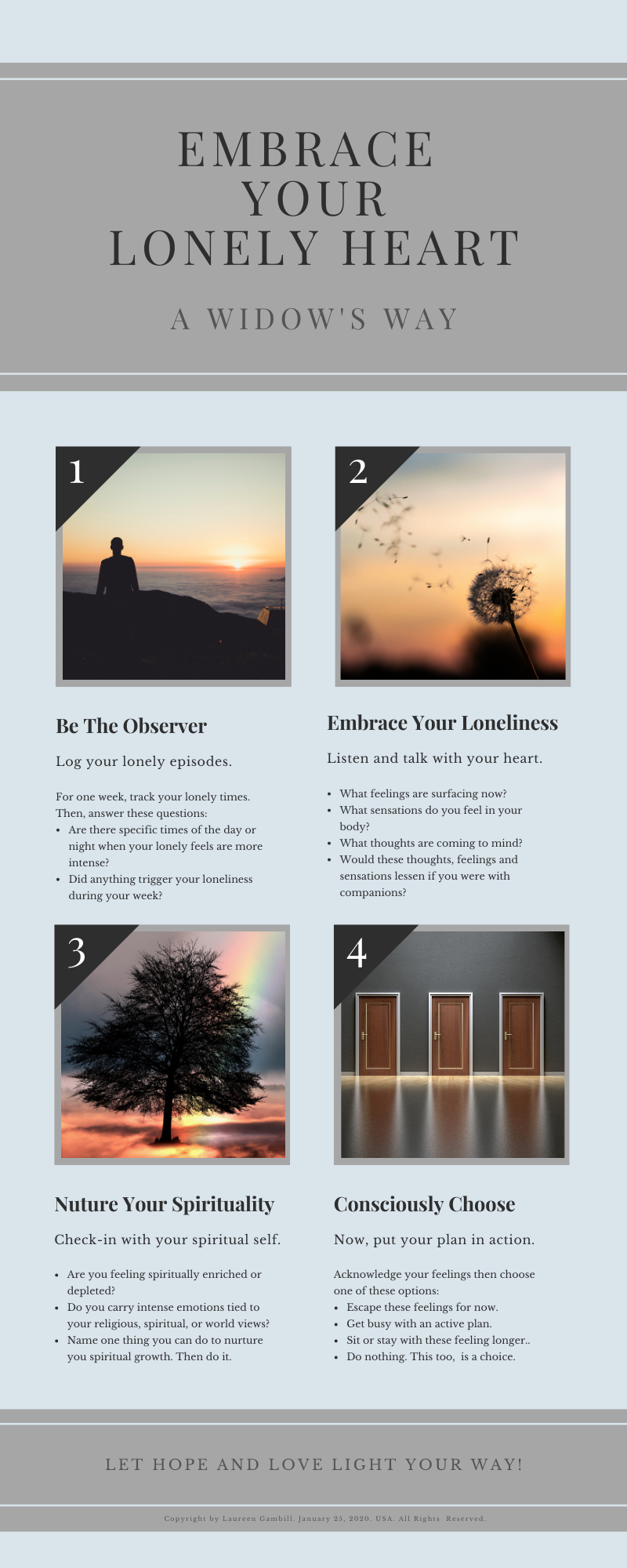My bouts with loneliness are coming more frequently now that the new year has started in earnest.
The rush of the holiday season is over, and stores are now filled with Valentine’s Day merchandise. Publications, including social media, have ads for celebrating love with your special person. Ugh! I readily admit that this time of year triggers my yearnings and my loneliness.
Widowed for close to four years now, I’m adjusting to this new life. Hobbling my forward momentum is the loneliness that sometimes surfaces in strong waves. I’ve learned that when the surge of loneliness comes, I need to lean in and embrace my lonely heart.
Determined to rebuild my life moving forward, I created a four-step approach to ease the grasp that loneliness has on me. Gleaned from gems of conversations with others, the gist of articles and books read, and by recalling my hopes and dreams from my childhood forward, I’m succeeding. Even now, during this triggering time of year, my loneliness is abating.
You can succeed too! You can create a custom strategy that has the voltage necessary to spark hope, create forward movement, and even develop a sense of peace.
I’m sharing my personal strategy for understanding and easing my lonely heart. Yours can be anything you believe will work for you and you are willing to put into action. Just commit to trying it for enough time to fairly test your strategy—at least one month or longer.
Embracing Your Lonely Heart — Four Steps
When your lonely heart begs for attention, turn and lovingly embrace it. Your heart is trying to communicate an essential message to you. Listen and have a conversation with your heart.
1. Be the Observer
Commit to logging your lonely episodes for one week. By doing so, you’ll gain valuable insight into your lonely feelings. Keep it simple. Track your observations of the following questions:
>> Are there specific times of the day or night when episodes of loneliness come up? If so, when?
>> When the feelings of loneliness occur, was there a trigger? Explore your ideas of what you think may have set this feeling in motion.
Try this: Complete a daily log for one week. At the end of the week, review your notes and look for recurring times or patterns. Write down your observations, using the following questions as a guide:
>> Did you notice any specific time of day when your loneliness appears most often?
>> What triggers did you have, if any? A simple list is excellent; for example: our song, shopping for the kids (school, birthday, or holiday), having coffee alone.
>> At the end of the entries for the week, jot down any insight you’ve gained by keeping this daily loneliness log.
You may want to try this again in a few weeks, then compare your notes. Doing so will add an understanding of your loneliness as well as allow you to see your progress visually.
2. Embrace Your Loneliness
When loneliness strikes your thoughts and emotions, allow it to be present. Sure, it’s uncomfortable, perhaps even causing physical symptoms or pain. However, it freely fades once you turn to face your loneliness. Learn to understand it and let the emotional and physical sensations appear. Ask yourself this: “Am I lonely or do I desire companionship?” There is a difference.
Simply defined, loneliness boils down to: “I’m not getting enough of what I want and need from my relationships.”
It may feel as if you’re not genuinely connecting with others. You may feel you’re not on the same wavelength — even when you have friends or loved ones around and your activity schedule is full. When engaged in social activities, talking, and laughing, your loneliness may have you feeling as if you’re there, but not there, and perhaps feeling out of place, all at once.
Powerless to change our circumstances, the death of our closest companion — our spouse or life partner — shifts our bonds with other people. We are not the same person we were before our loss.
“A part of me died right along with wife,” my friend Vince told me. Exactly! How many of us feel the same way? It’s hard to not be lonely when you don’t know your widowed self well, and a significant part of you is no longer present.
Truth: You may live alone and not experience loneliness. Many people are comfortable with solitude and are not lonely. When the desire for companionship arises, they fulfill that need. Feeling genuinely connected to another person or several others, in a sincere and assured manner, is an important factor for not feeling lonely.
Truth: You may live with other people you share a genuine love and concern with and still feel loneliness. Having a strong support network, being dearly loved, and well cared for, does not guarantee a lack of loneliness.
Be assured that loneliness is something most humans experience at some point in their lives — especially during times of grief and loss. But know that, like grief, loneliness is unique for each person. Also, the depth of lonely feelings may change rather quickly, depending on the circumstances and the emotional connection felt with others at the time.
Deciphering whether you’re lonely or desire companionship is accomplished by taking a few moments to examine your thoughts, feelings, and the physical sensations you are experiencing. Make a mental (or written) note of your answers to the following questions:
>> What emotions are surfacing for you now?
>> What sensations are you feeling in your body?
>> What thoughts are coming to your mind?
>> Would these thoughts, emotions, and sensations lessen if you were around another person or a group of people — just hanging out, or participating in an activity, even as an observer?
Please, don’t dwell on the uncomfortable feelings and sensations of loneliness. Seriously, it’s better that you don’t! Once you’ve acknowledged its presence and felt all that loneliness has brought you this time, get active. Have a strategy and a plan. Not only will you be able to soothe your loneliness for the moment, but you may also come to honor the knowledge that loneliness has taught you.
3. Nurture Your Spirituality
Loneliness often backs down when you tune-in spiritually. Check in with your spiritual self during lonely times. Even if you don’t consider yourself religious, there is a “spiritual” component to each of us.
>> Are you feeling spiritually enriched or depleted right now?
>> If you’re feeling spiritually depleted, what could you do to change that feeling?
>> Do you carry anger or intense emotions tied to your spiritual beliefs?
>> Consider how you can nourish your spiritual growth.
4. Consciously Choose
After acknowledging your lonely heart, consciously choose your next move. Your choices may include:
>> Escaping the lonely feelings for now.
>> Getting busy with any kind of activity.
>> Sitting or staying with your lonely feelings for a little longer.
>> Doing nothing. This too is a choice.
Really, it’s your choice! No matter what you choose, it’s okay! There is no judgment here.
You can choose to remain lonely. Some people do. Many people believe being lonely is a side-effect of remaining faithful to their vow of life-long love and devotion to their late spouse. Some find safety in their lonely hearts. There are many other personal reasons too.
Another choice is to do some work to ease the impact your loneliness has on your mood, your life view, as well as your motivation to accept your current life circumstance, future aspirations, and more.
Whatever your choice, embrace your lonely heart! Surrender to the feelings and sensations of loneliness that often bubble to the surface from our subconscious. Acknowledge them. Don’t suppress them. Listen to what your lonely heart is telling you. Then, when you’re ready, return to the present moment and experience what life is offering you, right now.
I’d love to hear the methods and strategies you’ve tried to help ease your loneliness.
Let hope and love light your way!










Read 0 comments and reply